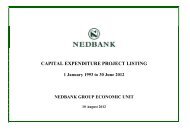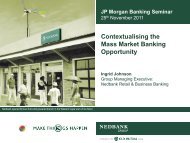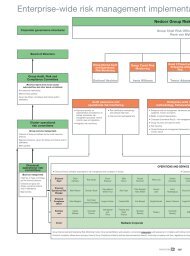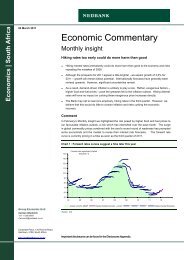2009 Annual report - Nedbank Group Limited
2009 Annual report - Nedbank Group Limited
2009 Annual report - Nedbank Group Limited
You also want an ePaper? Increase the reach of your titles
YUMPU automatically turns print PDFs into web optimized ePapers that Google loves.
Notes to the Consolidated <strong>Annual</strong> Financial StatementsFOR THE YEAR ENDED 31 DECEMBER <strong>2009</strong>1. BASIS OF PREPARATIONThe financial statements of NedNamibia Holdings (the “Company”) and its subsidiaries (the “<strong>Group</strong>”) are prepared inaccordance with and comply with International Financial Reporting Standards (“IFRS”) adopted by the InternationalAccounting Standards Board (“IASB”), and interpretations issued by the International Financial Reporting InterpretationsCommittee (“IFRIC”) of the IASB and the requirements of the Namibian Companies Act and the Namibian Banks Act.The financial statements are presented in Namibian Dollar (“N$”), the functional currency, and are rounded to the nearestthousand Namibian Dollar. The financial statements are prepared on the historical cost basis except that the followingassets and liabilities are stated at their fair value:– financial assets and financial liabilities classified as at fair value through profit or loss;– financial assets classified as available-for-sale; and– owner-occupied properties.The accounting policies set out below have been applied consistently to all years presented in these financial statements.Critical accounting judgements and key sources of estimation uncertaintyIn the preparation of the financial statements the <strong>Group</strong> has recorded various assets and liabilities on the presumptionthat the <strong>Group</strong> is an ongoing business and as such, certain key sources of estimation have been assumed:Credit impairmentThe <strong>Group</strong> applies an incurred loss approach to impairment. Impairment losses are incurred only if there is objectiveevidence of impairment as a result of one or more past events that have occurred since initial recognition. This necessitatesthe establishment of “impairment triggers” on the occurrence of which an impairment loss is recognised.Credit impairment is based on discounted estimated future cash flows on an asset or group of assets, where such objectiveevidence of impairment exists. The discount rate used to calculate the recoverable amount excludes consideration of anyanticipated future credit losses.The <strong>Group</strong> has also raised an impairment for incurred but not <strong>report</strong>ed (“IBNR”) losses. The purpose of the IBNR reserveis to allow for latent losses on a portfolio of loans and advances that have not yet been individually evidenced. Generally,a period of time will elapse between the incurrence of an impairment event and objective evidence of the impairmentbecoming evident, which is known as the “emergence period”. The IBNR reserve is based on the probability that loans thatare ostensibly performing at the calculation date are impaired, and objective evidence of that impairment becomes evidentduring the emergence period.Fair value of financial instrumentsDirectors anticipate that changing one or more of the assumptions used in the determination of fair value offinancial instruments to reasonably possible alternative assumptions will not change the fair value of these financialinstruments significantly.GROUP ANNUAL FINANCIAL STATEMENT S 69

















